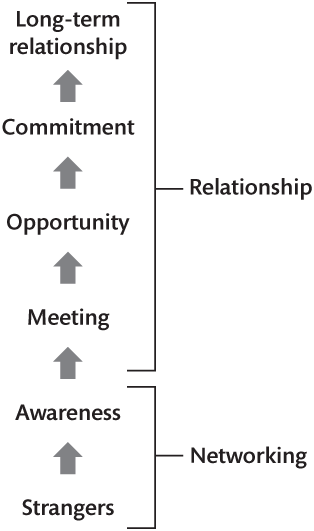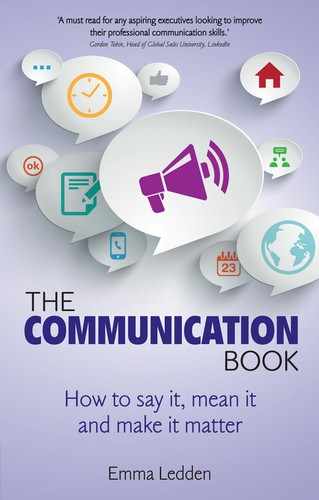STEP 1
Know the purpose
Hands up who loves networking? I don’t have my hand up either.
Networking is like dating – emotionally exhausting, mentally draining and just when you think you’ve met the man of your dreams, he begins the date with the phrase – ‘I Googled you’. (True story.)
Like dating, networking involves a series of awkward interactions where you must be pleasant, polite and make sure you don’t do anything you will regret the next day.
Networking = work. So why bother networking? Well for the same reason we date: connection. We are trying to find ‘our people’. Find our tribe. Our tribe will support us and help us move along in our career. Our tribe will become our clients, customers or maybe even our friends.
Meet Laura
I would like to introduce you to Laura. Laura attends many networking events, but doesn’t seem to get what she needs from them. Laura is not really clear what she needs from her networking, but she soldiers on – spending more and more of her precious time networking.

This is typically the approach Laura takes to a networking event:
- Laura has no real aim or mission when she attends this event, she just has a vague notion of networking.
- The conference starts at 8.00pm and Laura arrives at 7.55pm.
- Laura runs straight to her comfort zone – the tea/coffee area.
- Laura then grabs onto the first person she knows, a friend of hers who is also attending the event.
- The bell rings and Laura goes in to listen to the presentations or have dinner.
- At dinner Laura speaks only to the people on either side of her.
- Laura waits for the acceptable time after dinner and then leaves.
- She jumps into a taxi and wakes up at 6am the next morning exhausted and feeling like networking is not working for her.
What is networking?
Networking is not about selling. Networking is not about instant gratification. Networking is not a one-night stand; it is the first encounter in what you hope will be a long-term relationship.

Networking is about meeting people – new people. It is about talking to people and seeing if you have a business-relationship future together.
The first step to great networking is to meet as many of the right people as you can, talk to them and see if you can get to know them better.
So what did Laura do wrong in her approach to networking?
Unfortunately, quite a lot.
STEP 2
Understand your listener
Now let me introduce you to Mark
Mark believes networking is very important and he is very good it at. Mark attends many networking events and is very clear on his networking objective and what he wants to achieve. Mark is married with two children so he can’t be out all night, every night, networking.

This is how Mark approaches a typical networking event:
- Before he goes near the conference he identifies the three people he wants to meet and talk to.
- How? He calls the conference organiser and gets the list of attendees. Not an easy thing to achieve and he usually has to do some negotiation to get it.
- Once he has the list of attendees he picks the three people he wants to meet and does some research on them on the internet.
- Remember, Laura arrived at 7.55pm, grabbed a tea or coffee and headed into the presentation or dinner, speaking only to the people beside her. Mark does not do this. Mark arrives at the networking event 30 minutes early. Why? It means he can grab people as they come in. He doesn’t have to break into existing groups.
- If he doesn’t know what his target person looks like, he will ask the organiser to let him know when they come in. When he or she arrives he goes straight over, introduces himself, chats for a few minutes and then arranges to follow up in the most suitable way.
- How does he know what to say? He knew who he was meeting so he researched them a little and has a conversation-starter ready.
- By 7.55pm, if he chooses, Mark is able to go home when everyone else (including Laura) is going in to dinner.
WHAT MARK DOES IN MORE DETAIL
- He has a clear networking goal to meet three people.
- He gets the list of attendees in advance.
- He does some research and prepares what to say to the people he wants to meet.
- He proactively and confidently approaches his target people.
- He keeps it simple, short and engaging, as his goal is to get a follow-up meeting, not to sell on the spot.
What if you can’t get hold of the attendee list?
A huge part of Mark’s success lies in his preparation and ability to get the attendee list. In most cases you should be able to do this but, if not:
- look at the speakers and the event and try to figure out which industries/people are likely to be there;
- on the day of the event, arrive early and ask the organiser for help identifying some key people to chat to;
- do your best to come up with an alternative strategy for meeting the right people before you attend, using your existing network and contacts.
OK, you are at the event and you have to talk to complete strangers. . . What do you do?
STEP 3
Prepare to speak
Working the room
In order to work the room at your networking event you need to be able to:
- break into existing groups;
- have an interesting conversation ready;
- move on when necessary.
Breaking into existing groups
If you are not able to grab people as they come in the door then you may need to break into existing groups of two or more people and join their conversation.
The first thing to remember is, it is a networking event and people are all there for the same reason. It is not helpful to have an ‘I don’t want to disturb them’ mind-set when networking. Generally, people do not mind you joining them.
If in doubt about this, always take a moment or two to hover a little and get a sense of the conversation you are breaking into.
Once you feel ready, walk up confidently and say: ‘Hi. Do you mind if I join you?’.
Having a conversation ready
If you are breaking into a group and want to begin a general conversation then:
- Talk about the event – have they been to it before and is it different to last year?
- Offer a story or anecdote or something of interest to the group.
If you are starting a conversation with an individual:
- Research them in advance as this will give you something to say; this is the ideal scenario.
- If you haven’t been able to research them, say ‘I simply wanted to put a name to the face. It is lovely to meet you, here is my business card. Could I give you a call sometime to talk with you in more detail about your company and the work you do?’
- The best networkers do less talking and more listening. Show an interest in the person you are talking to and ask questions. People love talking about themselves.
WHAT DO YOU DO?
The most common question you will be asked at any networking event is ‘What do you do?’.
This question is an opportunity to explain to people what you do in a short time-frame and in a way that will leave them wanting more. A lot of people call the answer to this question their ‘elevator pitch’, the idea being, you have the time it takes to ride an elevator to tell someone what you do in an interesting and engaging way. The time suggested is 60 seconds.
Remember, the point of networking is to get a follow-up meeting and to start building a relationship. Elevator pitches should not involve any kind of selling. The goal is to say enough to gain the person’s interest, so that they will want to know more.
QUESTIONS TO ASK WHEN CREATING YOUR ELEVATOR PITCH
- What service/product do I offer?
- What problem does it solve or need does it meet?
- How am I different?
Here are some examples of elevator pitches to give you a flavour of what yours might look like.

‘You know how most business people use PowerPoint but don’t know how to use it properly, which can lead to loss of sales or reputation? My company shows businesses how to create presentations and use PowerPoint to communicate their great ideas in the right way. We use a unique method we developed based on the techniques used on TV.’
‘I consult time-challenged business owners on how to build teams and become more productive and profitable. I’m in a unique position to help my clients because I’ve faced the same struggles myself. I have figured out a formula that can help just about any entrepreneur build a team, giving them the time they need to grow their businesses.’
‘My company develops mobile applications that businesses use to train their staff remotely across the globe. The approach we use is unique because we visit each organisation to find out exactly what their people need and then build applications to suit them from there.’
HOW DO I STOP PEOPLE BREAKING AWAY FROM ME?
Remember, it is a networking event and everyone you talk to has their own goals, so you can’t monopolise their time. Don’t be afraid of the conversation ending. Give your business card and ask if it’s OK to follow up after the event.
While you are talking to someone you can do your best to keep them interested by asking them about themselves, talking about their business or any hobbies or current affairs topics you might share an interest in.
If you are going on and on about yourself they will want to run away.
Moving on when necessary
You will also want to move on from conversations to ensure you meet the three people you have planned for. Leaving a conversation politely and firmly is perfectly acceptable.
One way to do this is to say: ‘There is Mary. I was really hoping to talk to her, so please excuse me. It was a pleasure to meet you. I will email you in the next week.’
The other alternative is to introduce someone else to the person you are talking to and then leave.
Following up
The event is over and you achieved your goal of meeting your three key people.
What happens next?
If the first encounter went well and you feel it is right to take the next step, then you must get in touch and arrange the most appropriate follow up.
There are many methods you can use to follow up and keep in touch:
- a compliment slip with a relevant newspaper article;
- an email;
- a telephone call;
- an invitation to an event or to see round your office;
- an invitation to lunch or coffee.
However, there is a chance you will get to this follow-up stage and, despite an offer to meet or take things further, the relationship won’t develop. Part of good networking is recognising this and not letting it put you off future networking.
NETWORKING QUICK TIPS
- Don’t get drunk.
- Don’t talk about yourself the entire time.
- Listen actively.
- Have enough business cards with you.
- Avoid subjects that are inappropriate.
What’s in it for you?
A strong network can be an enormous asset to you as you build your career.
Your network can act as your coach, your recruiter, your advocate, your mentor and your sounding board.
A good network can introduce you to the right people, tell you about an internal job opportunity or expose you to ideas and ways of working you didn’t know existed.
Most importantly, your network knows you, supports you and values what you do.

